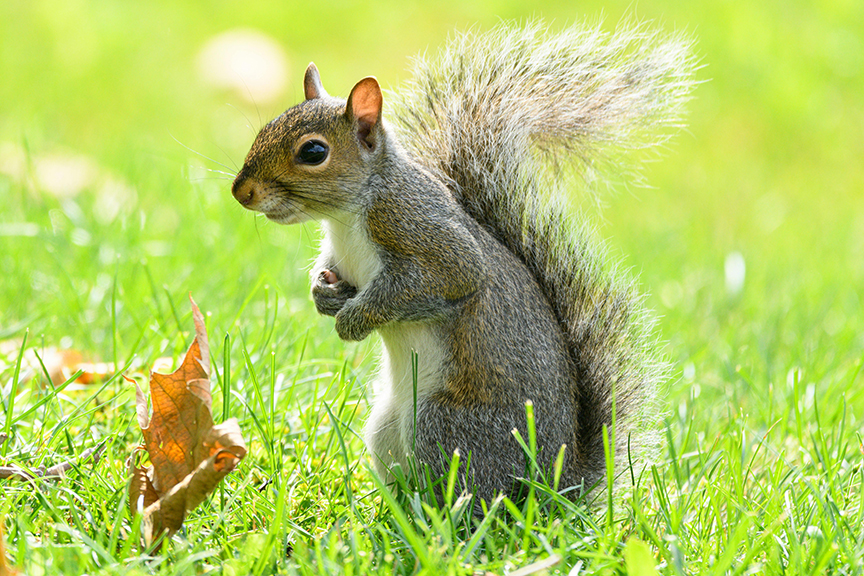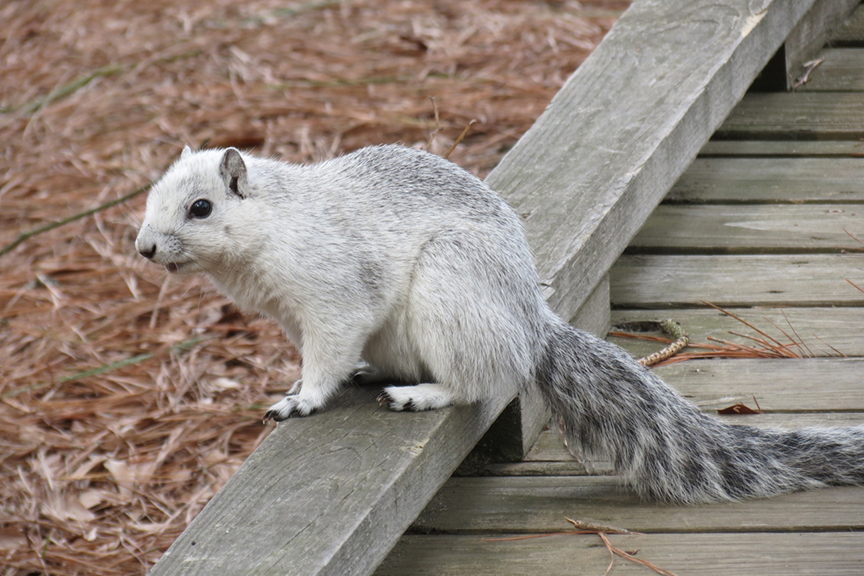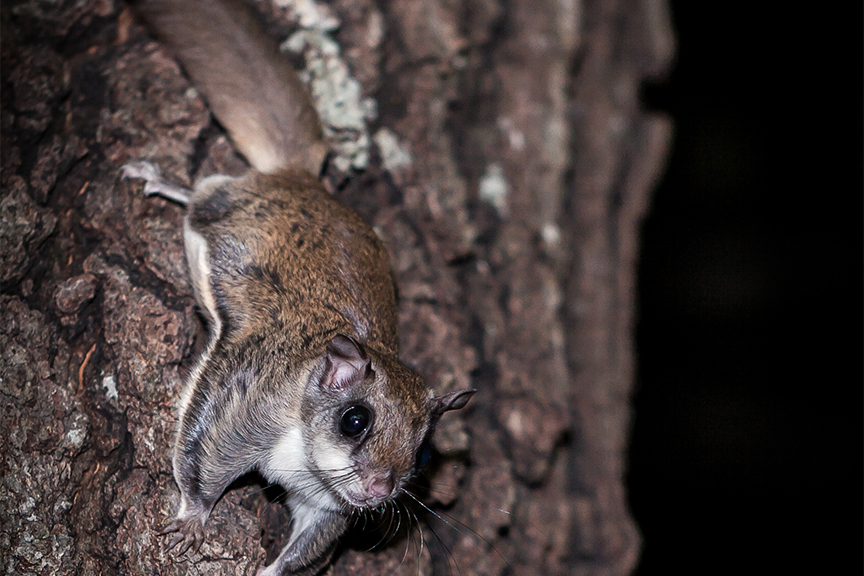October 2025

The coat of an eastern gray squirrel is actually a mixture of brown, black and white fur, but its torso appears gray from a distance. (photo by Jay Brand / Pexels.com)
by Kathy Reshetiloff, Bay Journal
The weather is still mild, but there is one animal that realizes the seasons will be changing soon: the squirrel. You may have already noticed these industrious mammals furiously burying nuts to recover when winter arrives and trees are bare.
Eastern gray squirrels can be found in fields and forests, farms and yards, and cities and suburbs. True to their name, they range throughout the eastern U.S.
The gray squirrel is recognized by a mixture of brown, black and white fur — which when viewed from a distance blend together to look gray. It has a white or light gray belly and a bushy gray tail tipped with silvery hair. Some gray squirrels are actually black, white or blond, although gray squirrels with these unusual coats are limited to particularly small locales. Sixteen to 20 inches in length, gray squirrels weigh up to 1.5 pounds.
Squirrels need trees, and the types that gray squirrels need the most include white oak, American beech, American elm, red maple and sweet gum. They use old woodpecker holes or natural tree cavities as dens to raise young or build large nests composed of leaves and twigs.
They eat a variety of seeds, nuts and berries, including acorns, hickory nuts, walnuts, beechnuts, pine seeds and American holly berries. In the spring, gray squirrels will also feed on buds of maple, tulip popular, American dogwood and black cherry. If these foods are scarce, they will turn to insects, bird eggs and small amphibians.
Eastern gray squirrels mate twice a year from December to February and from May to June. Litters range from two to six young, born hairless and helpless. The young are weaned in about 50 days. The second litter stays with the female over the winter.

The Delmarva fox squirrels are somewhat larger and generally lighter in color than gray squirrels. (photo by Lydia Hansen/USFWS)
Not as wide ranging or common as the gray squirrel, the Delmarva Peninsula fox squirrel, more commonly referred to as the Delmarva fox squirrel, is named for its home — the peninsula between the Chesapeake Bay and Atlantic Ocean, which includes parts of Delaware, Maryland and Virginia. The Delmarva fox squirrel is distinguished by its frosty silver-gray coat, bushy tail and large size, growing up to 30 inches (with half of that being tail) and weighing 1.5 to 3 pounds.
The Delmarva fox squirrel spends considerable time on the ground foraging for food. Mature forests of mixed hardwoods and pines provide abundant acorns and seeds and cavities for dens. They’ll switch to eating tree buds, flowers, fungi and insects in warmer months. Delmarva fox squirrels also visit farm fields to feed on corn and soybeans.
Active throughout the year, Delmarva fox squirrels typically mate in winter. About 44 days later, in February and March, young are born. The litters average one to four young, and the females raise the litters by themselves. The squirrels can have up to two litters per year. In winter, they tend to den in tree cavities. In summer, it’s more common for them to use leaf nests.
Historically, Delmarva fox squirrels could be seen throughout the Delmarva Peninsula and into Pennsylvania. However, their population and range declined due to timber harvesting, clearing of forests for agriculture and development, and hunting. In 1967, they inhabited only 10% of the peninsula and were placed on the first endangered species list.
The closing of the hunting season followed, enabling populations to rebuild in some areas. Capturing some Delmarva fox squirrels and releasing them in new areas helped increase the area they now occupy. Over time, populations increased, and squirrels dispersed to new areas. By 2015, Delmarva fox squirrels no longer needed protection under the Endangered Species Act.
Currently, Delmarva fox squirrels exist in eight counties on the Eastern Shore of Maryland (all but Cecil); Sussex County, DE; and Accomack County, VA. Hunting of Delmarva fox squirrels is prohibited in these states as conservation measures to improve the population are still being pursued.

The southern flying squirrel is notably smaller than the gray squirrel and might more accurately be called a gliding squirrel. (photo by Cephus / Wikimedia Commons)
Another very different squirrel resides in the Chesapeake Bay watershed: the southern flying squirrel. Although found in forests from southern Ontario to the Gulf Coast, southern flying squirrels are not often seen due to their stealth-like nightly habits. Only 8-10 inches long (including the tail), southern flying squirrels are gray to brown with a white belly, flattened tail, large ears and large black eyes.
But their most notable feature is a thin furry membrane of skin, known as a patagium, that runs along the sides of their bodies from the wrist of the front leg to the ankle of the hind leg. This membrane gives the squirrel its “flying” or, more accurately, gliding ability.
When the front and back legs are extended, the membrane forms a wing-like gliding surface, acting like a parachute while the flat tail serves as a rudder. This allows the squirrel to silently glide from tree to tree. Before landing, the squirrel drops its tail and lifts its front legs. This slackens the membrane and acts as a brake. Flying squirrels land as lightly and quietly as they glide and will immediately scurry to the other side of a tree trunk to avoid detection by predators.
There are two breeding periods for the southern flying squirrel. The first is February through March and the second is May through July. Litters average between three and four young, born hairless with eyes and ears closed, and weighing less than a quarter of an ounce. Development is slow. Ears open at 3 weeks; eyes open a week later. The young are weaned by 6 to 8 weeks and are then capable of gliding.
Southern flying squirrels favor beech-maple, oak-hickory and live oak forests. Tree cavities serve as nest sites. Not surprisingly, their primary foods include nuts such as acorns and hickory nuts, but they will also eat berries, seeds, fruits, buds, flowers, mushrooms and bark.
As the days shorten, flying squirrels also become hoarders, either burying nuts or stashing them in cavities or cracks and crevices of trees. They do not hibernate but may remain in nests for several days during severe weather. Groups of flying squirrels may gather in one cavity to conserve warmth.
Although they are very different in their appearance, population numbers and range, each of these squirrels that are native to the Bay watershed require stable, sustainable forests for food, homes and nesting sites. However, each species requires forest habitat made up of specific tree species and even tree ages. Conservation of diverse forest types is key to supporting them.
This column originally appeared in the Chesapeake Bay Journal, which provides independent environmental news for the Chesapeake region.
